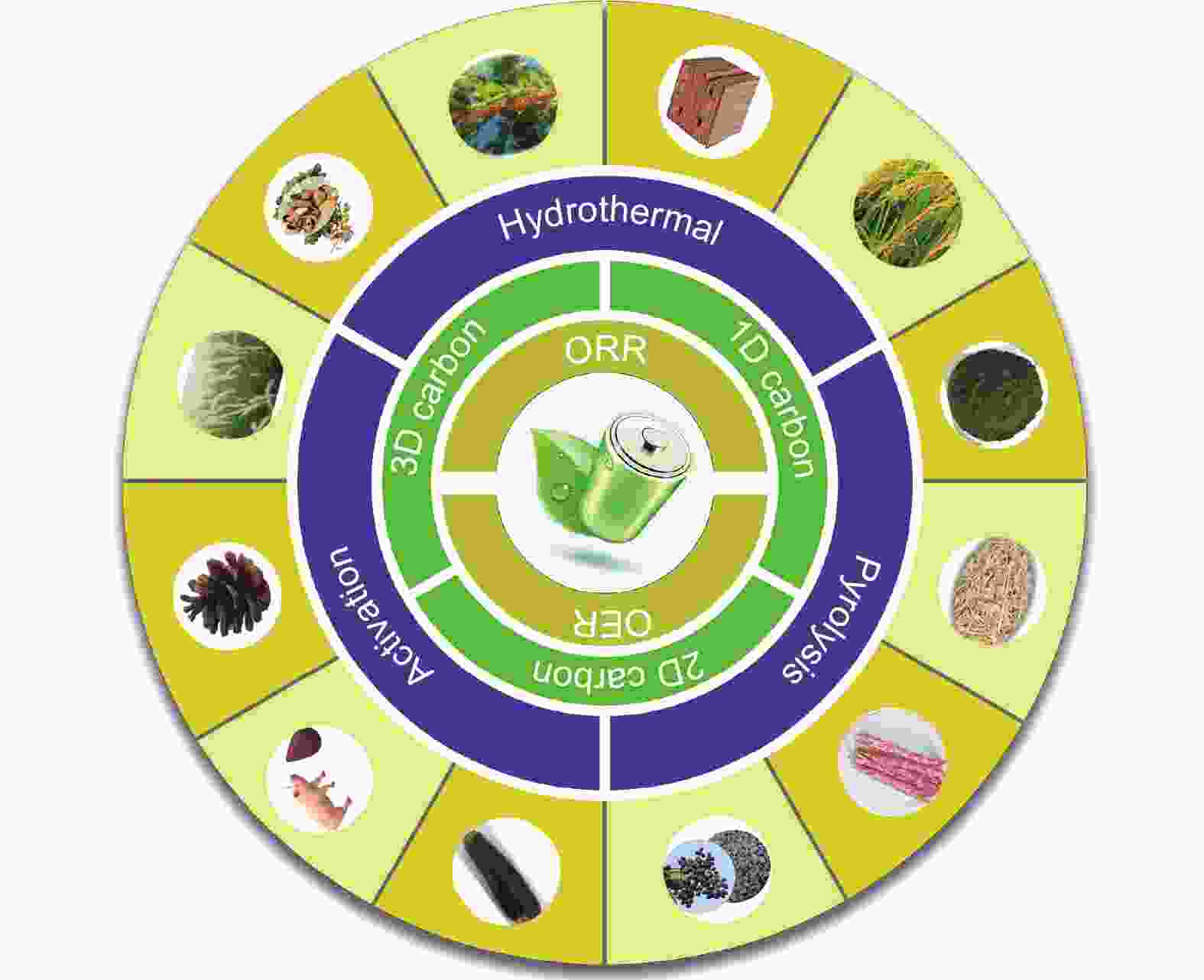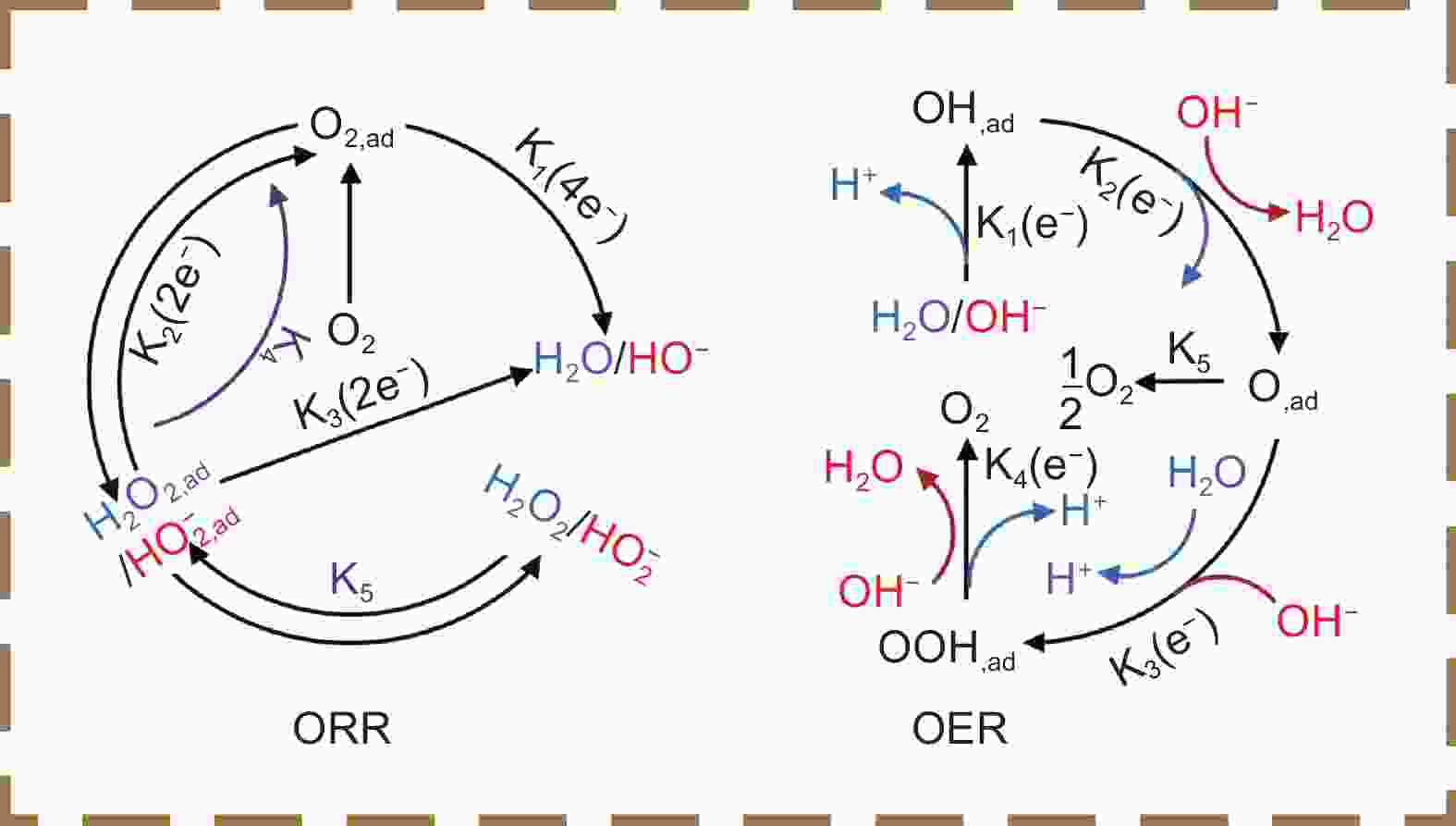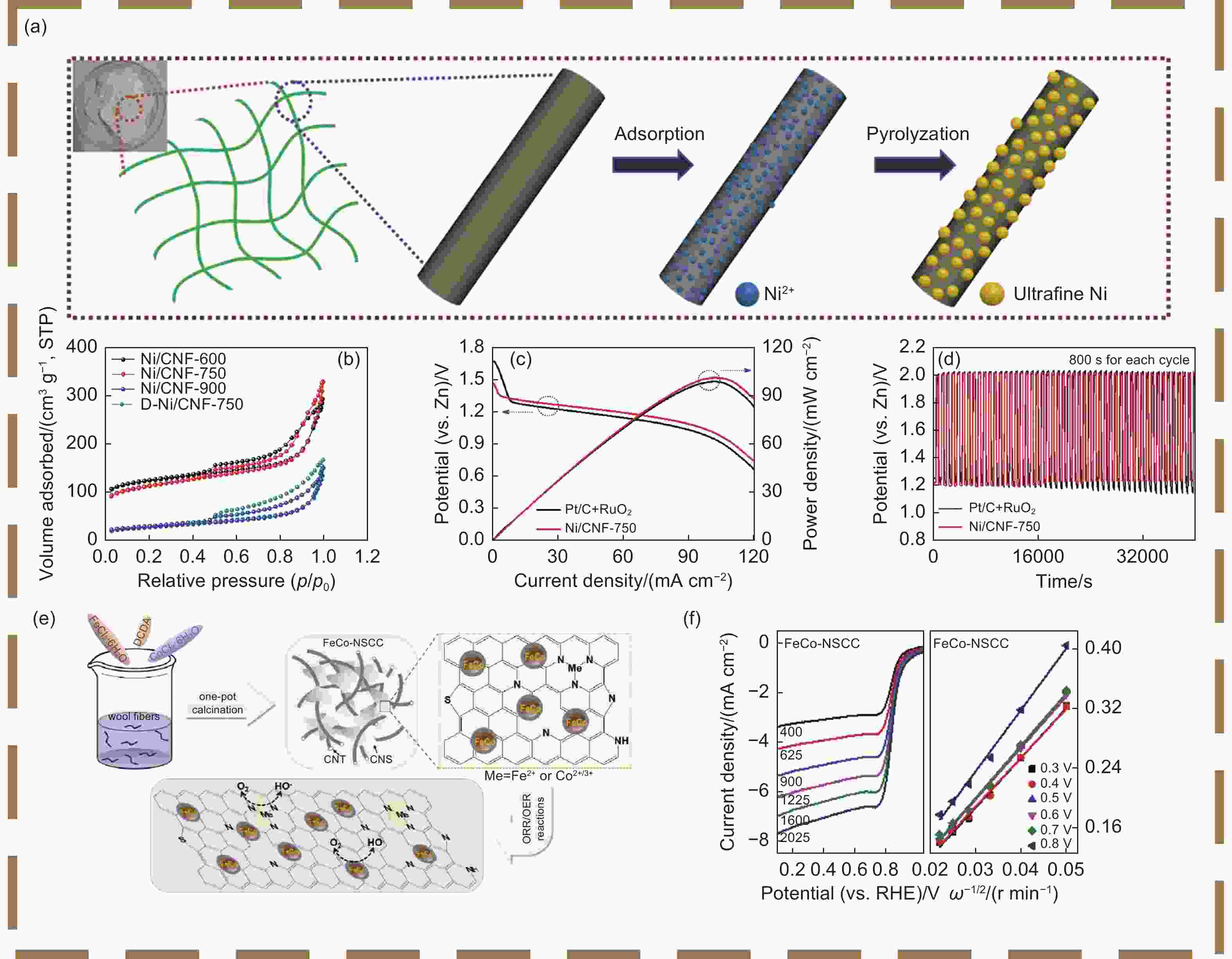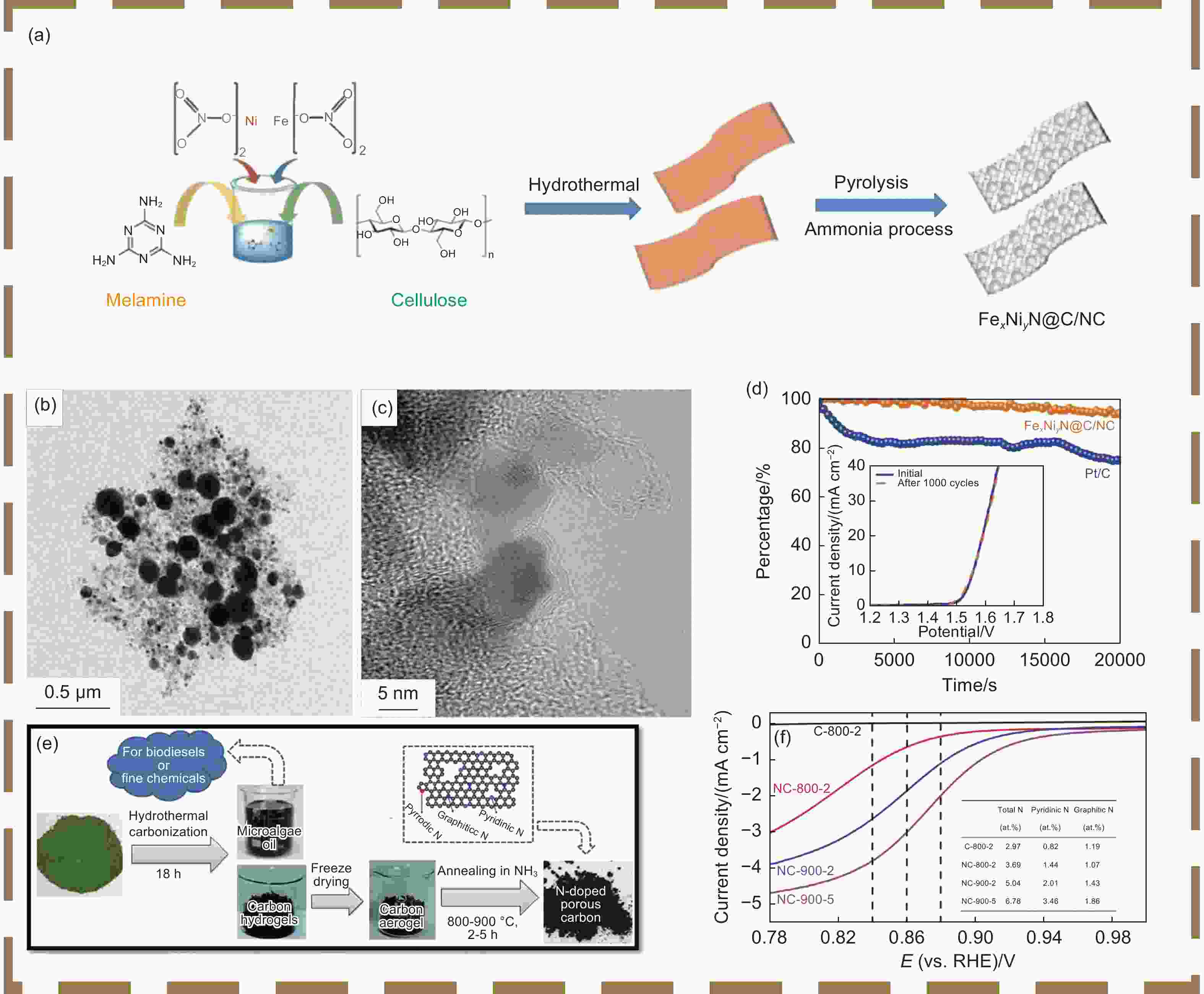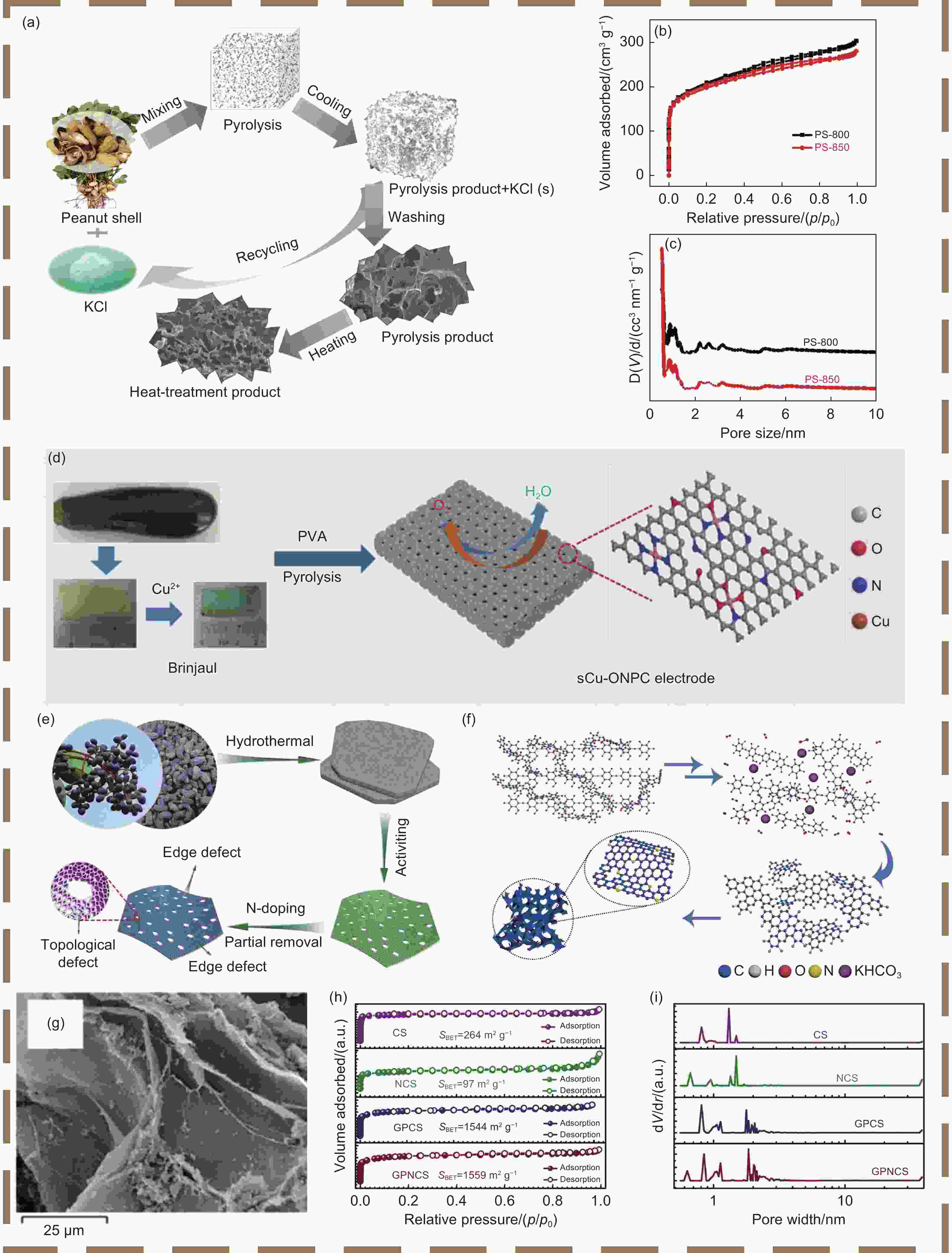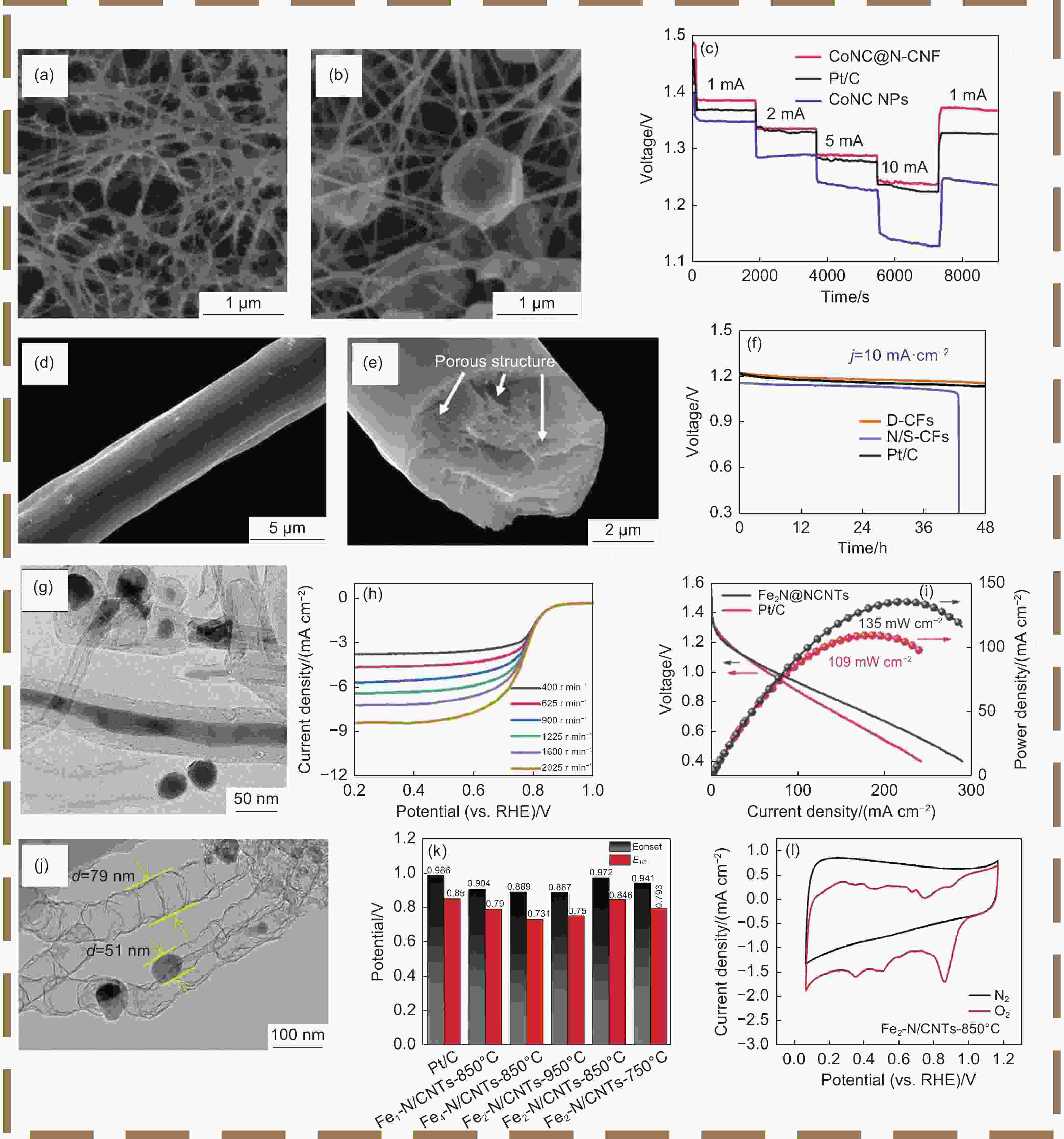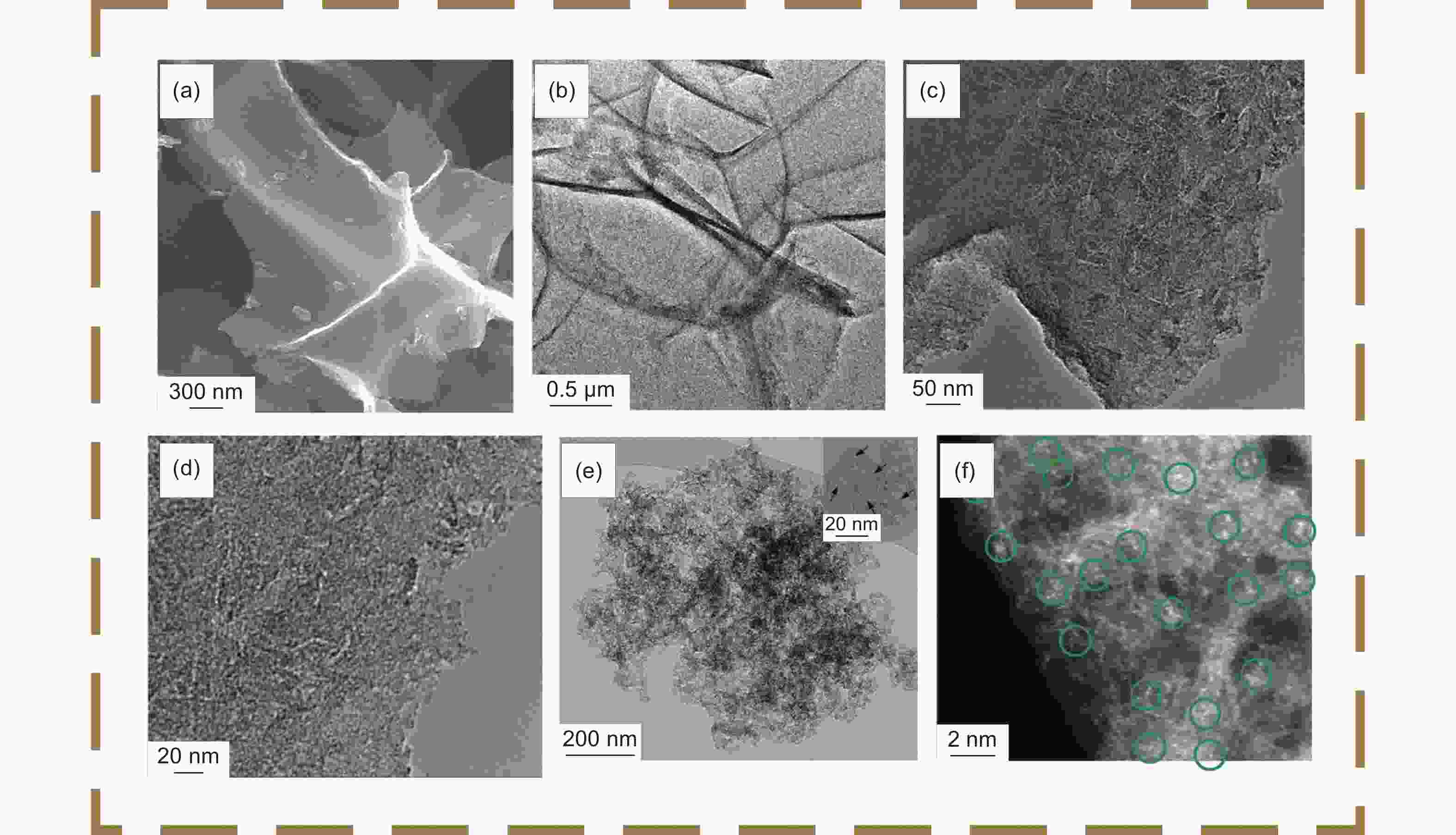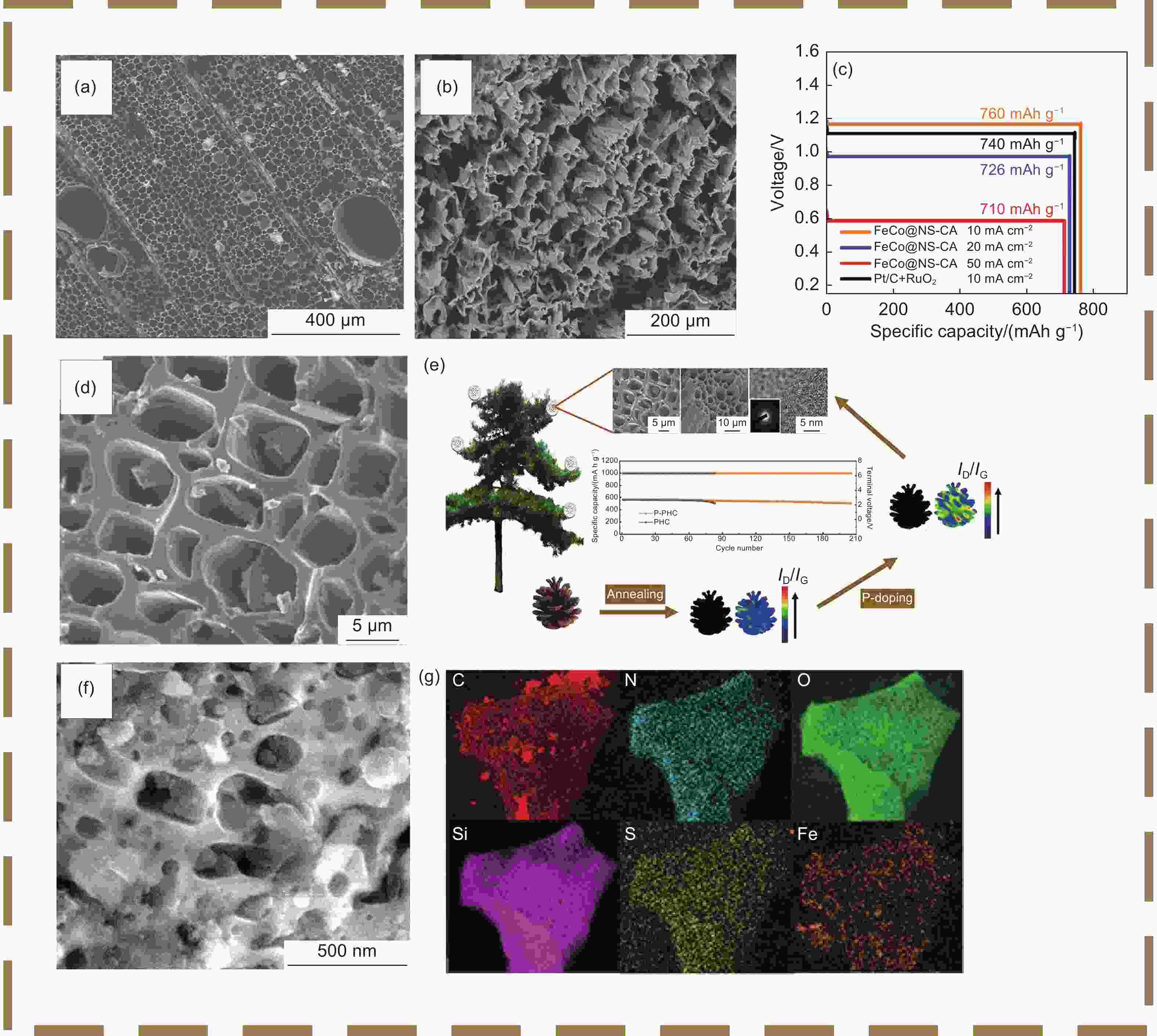-
摘要: 金属空气电池作为高效的能源转换与存储装置,受到人们广泛关注。然而,阴极反应动力学缓慢及贵金属高昂的成本等一系列问题严重制约了金属空气电池的实用化进程。生物质炭材料因其特殊的电化学性能、环境效益和经济价值,已成为开发高性能金属空气电池阴极材料的重要选择。近年来,生物质炭材料在材料制备和微观结构设计等方面取得了较大进展。本文综述了生物质炭材料在金属空气电池阴极应用的最新研究进展,并从反应机理、合成策略和多维结构(一维、二维和三维)的角度深入阐述其对电催化性能的影响。最后,进一步讨论了生物质炭材料面临的挑战和未来的发展方向。这篇综述为生物质炭材料的结构设计提供了新的视角,旨在为开发高效、廉价和稳定的金属空气电池阴极催化剂提供参考和借鉴。Abstract: Metal-air batteries have received significant attention as highly efficient energy conversion and storage devices. Nevertheless, several difficulties, such as the sluggish reaction kinetics of the cathode and the high cost of precious metals, have significantly hampered their commercialization. Biomass carbon materials have emerged as an important alternative for the development of high-performance cathode materials in metal-air batteries, owing to their remarkable electrochemical characteristics, environmental friendliness and cost effectiveness. In recent years, there has been huge progress in the preparation and design of biomass carbon materials. This review summarizes the most recent research on these materials, and the effects of the reaction mechanism, synthesis method and multidimensional (1D, 2D, 3D) structure on their electrocatalytic performance are reviewed. Finally, problems associated with their use and possible new developments are discussed. The review presents new perspectives on the structure of these materials, and provides a basis for the development of efficient, affordable, and stable cathode materials for metal-air batteries.
-
Key words:
- Biomass /
- Carbon materials /
- Metal-air battery /
- Cathode /
- Electrocatalysis
-
图 3 (a) BC生物质炭合成示意图[54];(b) N2的吸附-解吸等温线[54];(c) Ni/CNF-750放电极化与其功率密度曲线[54];(d) Ni/CNF-750充放电循环耐久性测试[54];(e) 羊毛生物质炭合成示意图[56];(f) 不同转速下的LSV曲线及K-L图[56]
Figure 3. (a) Synthesis diagram of BC biomass char[54], (b) N2 adsorption-desorption isotherms[54], (c) Ni/CNF-750 discharge polarization and its power density curve[54], (d) Ni/CNF-750 charge/discharge cycle durability[54], (e) Synthesis diagram of wool biomass carbon[56], (f) LSV curves and K-L plots at different speeds[56]. Reprinted with permission
图 4 (a) 纤维素炭材料的合成过程[58];(b) FexNiyN@C/NC催化剂和(c)TEM照片[58];(d) FexNiyN@C/NC和Pt/C在0.7 V时随时间变化图,插图:CV1000次循环前后FexNiyN@C/NC的OER极化图[58];(e) 海藻合成多孔炭的示意图[61];(f) 不同氮含量的催化剂的ORR效果图[61]
Figure 4. (a) Synthesis process of cellulose carbon materials[58]. (b) FexNiyN@C/N Catalyst and (c) TEM images[58]. (d) Chronoamperometric responses of FexNiyN@C/NC and Pt/C at 0.7 V, inset: OER of FexNiyN@C/NC before and after 1000 cycles of CV between 1.3 and 1.6 V[58]. (e) Diagram of a synthetic porous carbon from seaweed[61]. (f) Graph of ORR effect of catalysts with different nitrogen content[61]. Reprinted with permission
图 5 (a) 花生壳衍生炭材料合成路线示意图[67];(b) PS-800-100催化剂N2吸附-解吸曲线与(c) 孔径分布图[67]; (d) 茄子衍生炭材料合成过程[68];(e) 女贞子果实合成纳米片合成过程[69];(f) GPNCS的形成机理[69];(g) GPNCS纳米片SEM图像[69];(h) GPNCS的N2吸附-解吸图与(i) 孔径分布图[69]
Figure 5. (a) Diagram of the synthesis route of peanut shell-derived carbon materials[67]. (b) N2 adsorption-desorption curve and (c) pore size distribution of GPNCS[67]. (d) Synthesis process of eggplant-derived carbon material[68]. (e) Synthesis process of chasteberry fruit synthetic nanosheets[69]. (f) Mechanism of GPNCS formation[69]. (g) SEM image of GPNCS nanosheet[69]. (h) N2 adsorption-desorption diagram and (i) pore size distribution PS-800-100 catalyst[69]. Reprinted with permission
图 6 (a) 浸渍前细菌纤维素SEM照片与(b) 浸渍后SEM照片[84]; (c) 不同电流密度下的放电曲线[84]; (d)和(e) 海藻衍生炭D-CFs的SEM照片[85];(f) D-CFs-、N/S-CFs-和Pt/C基锌空气电池的静电放电曲线[85];(g) Fe2N@NCNTs催化剂TEM照片[82];(h) Fe2N@NCNTs阴极在不同转速下的LSV曲线[82];(i) Fe2N@NCNTs放电极化及其功率密度曲线[82];(j) 狼尾草衍生炭催化剂Fe2-N/CNTs-850 °C的TEM照片[83];(k) 不同狼尾草衍生炭与Pt/C催化剂起始电位与半波电位汇总图[83];(l) Fe2-N/CNTs-850 °C的CV曲线[83]
Figure 6. (a) SEM image of bacterial cellulose before impregnation and (b) SEM image after impregnation[84]. (c) Discharge curves at different current densities[84]. (d, e) SEM image of algal-derived carbon D-CFs[85]. (f) Electrostatic discharge curves of D-CFs-, N/S-CFs- and Pt/C-based zinc-air batteries[85]. (g) TEM image of Fe2N@NCNTs catalyst[82]. (h) LSV curves of Fe2N@NCNTs cathodes at different speeds[82]. (i) Discharge polarization of Fe2N@NCNTs and their power density curves[82]. (j) TEM image of wolfsbane derived carbon catalysts Fe2-N/CNTs-850 °C[83]. (k) Starting and half-wave potentials of different wolfsbane derived carbon and Pt/C catalysts[83]. (l) CV curves of Fe2-N/CNTs-850 °C[83]. Reprinted with permission
图 7 (a) 蔓越莓豆壳衍生炭(C-cranberry)SEM照片与(b)TEM照片[98];(c, d) 麦秸衍生炭(AC-HC)TEM照片[101];(e) 猪血衍生炭纳米片(Zn/FeSA-PC/950/NH3)TEM照片与(f) SEM照片[102]
Figure 7. (a) SEM images and (b) TEM images[98] of cranberry bean shell-derived carbon (C-cranberry). (c-d) TEM images of wheat straw-derived carbon (AC-HC)[101]. (e) TEM image of pig blood-derived carbon nanosheets (Zn/FeSA-PC/950/NH3) with (f) SEM image[102]. Reprinted with permission
图 8 (a) 巴沙木与(b) 脱木质素后SEM照片[106];(c) FeCo@NS-CA催化剂与Pt/C催化剂的比容量曲线[106];(d) 松果衍生碳SEM照片[108];(e) 松果衍生炭材料SEM照片及性能图[108];(f) 稻壳多孔炭SEM照片[110];(g) Si-Fe/S/N-RH3催化剂的元素映射图像[110]
Figure 8. SEM images of (a) balsa wood and (b) post delignification sample[106]. (c) Specific capacity curves of FeCo@NS-CA catalysts versus Pt/C catalysts[106]. (d) SEM image of pine cone derived carbon[108]. (e) SEM image and properties of pine cone derived carbon materials[108]. (f) SEM image of rice husk porous carbon[110]. (g) Elemental mapping images of Si-Fe/S/N-RH3 catalysts[110]. Reprinted with permission
-
[1] Qiao J, Kong L, Xu S, et al. Research progress of MXene-based catalysts for electrochemical water-splitting and metal-air batteries[J]. Energy Storage Materials,2021,43:509-530. doi: 10.1016/j.ensm.2021.09.034 [2] Jiang G, Senthil R A, Sun Y, et al. Recent progress on porous carbon and its derivatives from plants as advanced electrode materials for supercapacitors[J]. Journal of Power Sources,2022,520:230886. doi: 10.1016/j.jpowsour.2021.230886 [3] Nithish C, ZindaniI D, Das G, et al. Performance evaluation of metal-air batteries for sustainable agricultural equipment[J]. Materials Today: Proceedings,2022,71(2):281-286. [4] Jamesh M I, Moni P, Prakash A S, et al. ORR/OER activity and zinc-air battery performance of various kinds of graphene-based air catalysts[J]. Materials Science for Energy Technologies,2021,4:1-22. doi: 10.1016/j.mset.2020.12.001 [5] Hao R, Gu S, Chen J, et al. Microporous Fe–N4 cataysts derived from biomass aerogel for a high-performance Zn–air battery[J]. Materials Today Energy,2021,21:100826. doi: 10.1016/j.mtener.2021.100826 [6] Wang H F, Xu Q. Materials design for rechargeable metal-air batteries[J]. Matter,2019,1(3):565-595. doi: 10.1016/j.matt.2019.05.008 [7] Huang Z F, Wang J, Peng Y, et al. Design of efficient bifunctional oxygen reduction/evolution electrocatalyst: recent advances and perspectives[J]. Advanced Energy Materials,2017,7(23):1700544. doi: 10.1002/aenm.201700544 [8] Kaare K, Yu E, Volperts A, et al. Highly active wood-derived nitrogen-doped carbon catalyst for the oxygen reduction reaction[J]. ACS omega,2020,5(37):23578-23587. doi: 10.1021/acsomega.0c01974 [9] Sha J, Jiang S, Cai D, et al. Potato-derived N-doped carbon nanoparticles incorporated with FeCo species as efficiently bifunctional electrocatalyst towards oxygen reduction and oxygen evolution reactions for rechargeable zinc-air batteries[J]. Materials Science and Engineering:B,2023,290:116291. doi: 10.1016/j.mseb.2023.116291 [10] Vijayakumar E, Ramakrishnan S, Sathiskumar C, et al. MOF-derived CoP-nitrogen-doped carbon@NiFeP nanoflakes as an efficient and durable electrocatalyst with multiple catalytically active sites for OER, HER, ORR and rechargeable zinc-air batteries[J]. Chemical Engineering Journal,2022,428:131115. doi: 10.1016/j.cej.2021.131115 [11] Zheng H, Zhang Y, Long J, et al . Nitrogen-doped porous carbon material derived from biomass of beancurd as an efficient electrocatalyst for oxygen reduction and Zn-air fuel cell[J]. Journal of The Electrochemical Society,2020,167(8):084516. doi: 10.1149/1945-7111/ab907f [12] Liu H, Liu Q, Wang Y, et al. Bifunctional carbon-based cathode catalysts for zinc-air battery: A review[J]. Chinese Chemical Letters,2022,33(2):683-692. doi: 10.1016/j.cclet.2021.07.038 [13] Bhatia S K, Palai A K, Kumar A, et al. Trends in renewable energy production employing biomass-based biochar[J]. Bioresour Technol,2021,340:125644. doi: 10.1016/j.biortech.2021.125644 [14] Wang M, Yao Y, Tang Z, et al. Self-nitrogen-doped carbon from plant waste as an oxygen electrode material with exceptional capacity and cycling stability for lithium-oxygen batteries[J]. ACS Appl Mater Interfaces,2018,10(38):32212-32219. doi: 10.1021/acsami.8b11282 [15] Tiwari S K, Bystrzejewski M, De Adhikari A, et al. Methods for the conversion of biomass waste into value-added carbon nanomaterials: Recent progress and applications[J]. Progress in Energy and Combustion Science,2022,92:101023. doi: 10.1016/j.pecs.2022.101023 [16] Li X, Zhang J, Liu B, et al. A critical review on the application and recent developments of post-modified biochar in supercapacitors[J]. Journal of Cleaner Production,2021,310:127428. doi: 10.1016/j.jclepro.2021.127428 [17] Feng Y, Tao L, Zheng Z, et al. Upgrading agricultural biomass for sustainable energy storage: Bioprocessing, electrochemistry, mechanism[J]. Energy Storage Materials,2020,31:274-309. doi: 10.1016/j.ensm.2020.06.017 [18] Li D Y, Zhao L L, Xia Q, et al. Activating MoS2 nanoflakes via sulfur defect engineering wrapped on CNTs for stable and efficient Li‐O2 batteries[J]. Advanced Functional Materials,2021,32(8):2108153. [19] Wang Y J, Fan H, Ignaszak A, et al. Compositing doped-carbon with metals, non-metals, metal oxides, metal nitrides and other materials to form bifunctional electrocatalysts to enhance metal-air battery oxygen reduction and evolution reactions[J]. Chemical Engineering Journal,2018,348:416-437. doi: 10.1016/j.cej.2018.04.208 [20] Ipadeola A K, Eid K, Abdullah A M. Porous transition metal-based nanostructures as efficient cathodes for aluminium-air batteries [J]. Current Opinion in Electrochemistry, 2022, 37: 101198. [21] Wang S, Chen S, Ma L, et al. Recent progress in cobalt-based carbon materials as oxygen electrocatalysts for zinc-air battery applications [J]. Materials Today Energy, 2021, 20: 100659. [22] Fan M, Cui L, He X, et al. Emerging heterogeneous supports for efficient electrocatalysis [J]. Small Methods, 2022, 6(10): 2200855. [23] Tang W, Li B, Teng K, et al. Advanced noble-metal-free bifunctional electrocatalysts for metal-air batteries[J]. Journal of Materiomics,2022,8(2):454-474. doi: 10.1016/j.jmat.2021.07.001 [24] Zhu Y T, Yue K H, Xia C F, et al. Recent advances on MOF derivatives for non-noble metal oxygen electrocatalysts in zinc-air batteries[J]. Nano-Micro Letters,2021,13(1):137. [25] Zhao C X, Liu J N, Wang J, et al. Recent advances of noble-metal-free bifunctional oxygen reduction and evolution electrocatalysts[J]. Chemical Society Reviews,2021,50(13):7745-7778. doi: 10.1039/D1CS00135C [26] Chen Y H, Xu J J, He P, et al. Metal-air batteries: progress and perspective[J]. Science Bulletin,2022,67(23):2449-2486. doi: 10.1016/j.scib.2022.11.027 [27] Yaqoob L, Noor T, Iqbal N. An overview of metal-air batteries, current progress, and future perspectives[J]. Journal of Energy Storage,2022,56:106075. doi: 10.1016/j.est.2022.106075 [28] Sun Y, Liu X, Jiang Y, et al. Recent advances and challenges in divalent and multivalent metal electrodes for metal–air batteries[J]. Journal of Materials Chemistry A,2019,7(31):18183-18208. doi: 10.1039/C9TA05094A [29] Du Q, Gong Y, Khan M A, et al. Regulating non-precious transition metal nitrides bifunctional electrocatalysts through surface/interface nanoengineering for air-cathodes of Zn-air batteries[J]. Green Energy & Environment,2022,7(1):16-34. [30] Shi F, Zhu X, Yang W. Micro-nanostructural designs of bifunctional electrocatalysts for metal-air batteries[J]. Chinese Journal of Catalysis,2020,41(3):390-403. doi: 10.1016/S1872-2067(19)63514-X [31] Sekhon S S, Lee J, Park J S. Biomass-derived bifunctional electrocatalysts for oxygen reduction and evolution reaction: A review[J]. Journal of Energy Chemistry,2022,65:149-172. doi: 10.1016/j.jechem.2021.05.052 [32] Wu W F, Yan X, Zhan Y. Recent progress of electrolytes and electrocatalysts in neutral aqueous zinc-air batteries [J]. Chemical Engineering Journal, 2023, 451: 138608. [33] Timofeeva E V, Segre C U, Pour G S, et al. Aqueous air cathodes and catalysts for metal-air batteries [J]. Current Opinion in Electrochemistry, 2023, 38: 101246. [34] Zhang X, Wang L. Research progress of carbon nanofiber-based precious-metal-free oxygen reaction catalysts synthesized by electrospinning for Zn-air batteries[J]. Journal of Power Sources,2021,507:230280. doi: 10.1016/j.jpowsour.2021.230280 [35] Gao G, Waclawik E R, Du A. Computational screening of two-dimensional coordination polymers as efficient catalysts for oxygen evolution and reduction reaction[J]. Journal of Catalysis,2017,352:579-585. doi: 10.1016/j.jcat.2017.06.032 [36] Fu C, Jiang M. Innovative methods to couple earth-abundant biomass waste with air batteries[J]. Current Opinion in Electrochemistry,2019,15:133-139. doi: 10.1016/j.coelec.2019.04.029 [37] Liu X, Liu X, Li C, et al. Defect engineering of electrocatalysts for metal-based battery[J]. Chinese Journal of Catalysis,2023,45:27-87. doi: 10.1016/S1872-2067(22)64168-8 [38] Bhoyate S D, Kim J, de Souza F M, et al. Science and engineering for non-noble-metal-based electrocatalysts to boost their ORR performance: A critical review[J]. Coordination Chemistry Reviews,2023,474:214854. doi: 10.1016/j.ccr.2022.214854 [39] Lu F, Zhou M, Zhou Y, et al. First-row transition metal based catalysts for the oxygen evolution reaction under alkaline conditions: basic principles and recent advancess[J]. Small,2017,13(45):1701931. doi: 10.1002/smll.201701931 [40] Arafat Y, Azhar M R, Zhong Y, et al. Metal-free carbon based air electrodes for Zn-air batteries: Recent advances and perspective[J]. Materials Research Bulletin,2021,140:111315. doi: 10.1016/j.materresbull.2021.111315 [41] Qu K, Zheng Y, Dai S, et al. Graphene oxide-polydopamine derived N, S-codoped carbon nanosheets as superior bifunctional electrocatalysts for oxygen reduction and evolution[J]. Nano Energy,2016,19:373-381. doi: 10.1016/j.nanoen.2015.11.027 [42] Chang H, Shi L N, Chen Y H, et al. Advanced MOF-derived carbon-based non-noble metal oxygen electrocatalyst for next-generation rechargeable Zn-air batteries[J]. Coordination Chemistry Reviews,2022,473:214839. doi: 10.1016/j.ccr.2022.214839 [43] Ying J, Zheng D, Meng S, et al. Advanced design strategies for multi-dimensional structured carbon materials for high-performance Zn-air batteries[J]. New Carbon Materials,2022,37(4):641-657. doi: 10.1016/S1872-5805(22)60623-1 [44] Long Y, Ye F, Shi L, et al. N, P, and S tri-doped holey carbon as an efficient electrocatalyst for oxygen reduction in whole pH range for fuel cell and zinc-air batteries[J]. Carbon,2021,179:365-376. doi: 10.1016/j.carbon.2021.04.039 [45] Jia N, Liu J, Liu Y, et al. In situ conversion of iron sulfide (FeS) to iron oxyhydroxide (γ-FeOOH) on N, S co-doped porous carbon nanosheets: An efficient electrocatalyst for the oxygen reduction reaction and zinc-air batteries[J]. Journal of colloid and interface science,2020,558:323-333. doi: 10.1016/j.jcis.2019.09.083 [46] Hao X, Chen W, Jiang Z, et al. Conversion of maize straw into nitrogen-doped porous graphitized carbon with ultra-high surface area as excellent oxygen reduction electrocatalyst for flexible zinc–air batteries[J]. Electrochimica Acta,2020,362:137143. doi: 10.1016/j.electacta.2020.137143 [47] Liu Z, Li Z, Ma J, et al. Nitrogen and cobalt-doped porous biocarbon materials derived from corn stover as efficient electrocatalysts for aluminum-air batteries[J]. Energy,2018,162:453-459. doi: 10.1016/j.energy.2018.07.175 [48] Gomes V G, Dinh K N. Ni- and P-doped carbon from waste biomass: A sustainable multifunctional electrode for oxygen reduction, oxygen evolution and hydrogen evolution reactions[J]. Electrochimica Acta,2019,314:49-60. doi: 10.1016/j.electacta.2019.05.053 [49] Collard F X, Blin J. A review on pyrolysis of biomass constituents: Mechanisms and composition of the products obtained from the conversion of cellulose, hemicelluloses and lignin[J]. Renewable and Sustainable Energy Reviews,2014,38:594-608. doi: 10.1016/j.rser.2014.06.013 [50] Ma L L, Hu X, Liu W J, et al. Constructing N, P-dually doped biochar materials from biomass wastes for high-performance bifunctional oxygen electrocatalysts[J]. Chemosphere,2021,278:130508. [51] Chen X, Wei L, Wang Y, et al. Milk powder-derived bifunctional oxygen electrocatalysts for rechargeable Zn-air battery[J]. Energy Storage Materials,2018,11:134-143. doi: 10.1016/j.ensm.2017.10.011 [52] Huang Y, Tang K, Yuan F, et al. N-doped porous carbon nanofibers fabricated by bacterial cellulose-directed templating growth of MOF crystals for efficient oxygen reduction reaction and sodium-ion storage[J]. Carbon,2020,168:12-21. doi: 10.1016/j.carbon.2020.06.052 [53] Chen X, Chen D, Li G, et al. FeNi incorporated N doped carbon nanotubes from glucosamine hydrochloride as highly efficient bifunctional catalyst for long term rechargeable zinc-air batteries[J]. Electrochimica Acta,2022,428:140938. doi: 10.1016/j.electacta.2022.140938 [54] Liu G Q, Xia X, Zhao C J, et al. Ultrafine Ni nanoparticles anchored on carbon nanofibers as highly efficient bifunctional air electrodes for flexible solid-state zinc-air batteries[J]. Journal of Colloid and Interface Science,2021,588:627-636. doi: 10.1016/j.jcis.2020.11.053 [55] Sun K, Li J, Huang L, et al. Biomass-derived 3D hierarchical N-doped porous carbon anchoring cobalt-iron phosphide nanodots as bifunctional electrocatalysts for LiO2 batteries[J]. Journal of Power Sources,2019,412:433-441. doi: 10.1016/j.jpowsour.2018.11.079 [56] Liang X, Xiao H, Zhang T F, et al. A unique nanocomposite with FeCo nanoalloy anchored on S, N co-doped carbonaceous matrix for high bifunctional oxygen reduction reaction/oxygen evolution reaction electrocatalytic property in Zn-air battery[J]. Journal of Colloid and Interface Science,2023,630:170-181. doi: 10.1016/j.jcis.2022.10.001 [57] Tang X, Liu D, Wang Y J, et al. Research advances in biomass-derived nanostructured carbons and their composite materials for electrochemical energy technologies[J]. Progress in Materials Science,2021,118:100770. doi: 10.1016/j.pmatsci.2020.100770 [58] Wu M, Zhang G, Hu Y, et al. Graphitic-shell encapsulated FeNi alloy/nitride nanocrystals on biomass-derived N-doped carbon as an efficient electrocatalyst for rechargeable Zn-air battery[J]. Carbon Energy,2020,3(1):176-187. [59] Zaman S, Wang M, Liu H, et al. Carbon-based catalyst supports for oxygen reduction in proton-exchange membrane fuel cells[J]. Trends in Chemistry,2022,4(10):886-906. doi: 10.1016/j.trechm.2022.07.007 [60] Kim M J, Park J E, Kim S, et al. Biomass-derived air cathode materials: pore-controlled S, N-Co-doped carbon for fuel cells and metal–air batteries[J]. ACS Catalysis,2019,9(4):3389-3398. doi: 10.1021/acscatal.8b03730 [61] Hu X, Ma L L, Liu W J, et al. Microalgae biomass-derived nitrogen-enriching carbon materials as an efficient pH-universal oxygen reduction electrocatalyst for Zn-air battery[J]. Science of The Total Environment,2021,782:146844. doi: 10.1016/j.scitotenv.2021.146844 [62] Zhang M, Zhang J, Ran S, et al. Biomass-derived sustainable carbon materials in energy conversion and storage applications:Status and opportunities. A mini review[J]. Electrochemistry Communications,2022,138:107283. doi: 10.1016/j.elecom.2022.107283 [63] Wang H F, Tang C, Zhang Q. A review of precious-metal-free bifunctional oxygen electrocatalysts: rational design and applications in Zn-air batteries[J]. Advanced Functional Materials,2018,28(46):1803329. doi: 10.1002/adfm.201803329 [64] Jing S Y, Gai Z J, Li M X, et al. Enhanced electrochemical performance of a Li-O2 battery using Co and N co-doped biochar cathode prepared in molten salt medium[J]. Electrochimica Acta,2022,410:140002. doi: 10.1016/j.electacta.2022.140002 [65] Zhao C, Liu G, Sun N, et al. Biomass-derived N-doped porous carbon as electrode materials for Zn-air battery powered capacitive deionization[J]. Chemical Engineering Journal,2018,334:1270-1280. doi: 10.1016/j.cej.2017.11.069 [66] Wang F Z, Li X L, Xie Y M, et al. Effects of porous structure on oxygen mass transfer in air cathodes of nonaqueous metal–air batteries: A mini-review[J]. ACS Applied Energy Materials,2022,5(5):5473-5483. doi: 10.1021/acsaem.2c00656 [67] Qiao Y, Zhang C, Kong F, et al. Activated biochar derived from peanut shells as the electrode materials with excellent performance in zinc-air battery and supercapacitance[J]. Waste Manag,2021,125:257-267. doi: 10.1016/j.wasman.2021.02.057 [68] Wang Y F, Jin M, Zhang X, et al. Direct conversion of biomass into compact air electrode with atomically dispersed oxygen and nitrogen coordinated copper species for flexible zinc-air batteries[J]. ACS Applied Energy Materials,2019,2(12):8659-8666. doi: 10.1021/acsaem.9b01614 [69] Liu Y, Sun K, Cui X, et al. Defect-rich, graphenelike carbon sheets derived from biomass as efficient electrocatalysts for rechargeable zinc–air batteries[J]. ACS Sustainable Chemistry & Engineering,2020,8(7):2981-2989. [70] Kuo H C, Lin Y G, Chiang C L, et al. FeN@N-doped graphitic biochars derived from hydrothermal-microwave pyrolysis of cellulose biomass for fuel cell catalysts[J]. Journal of Analytical and Applied Pyrolysis,2021,153:104991. doi: 10.1016/j.jaap.2020.104991 [71] Shaker M, Ghazvini A A S, Cao W, et al. Biomass-derived porous carbons as supercapacitor electrodes-a review[J]. New Carbon Materials,2021,36(3):546-572. doi: 10.1016/S1872-5805(21)60038-0 [72] Li Z, Guo D, Liu Y, et al. Recent advances and challenges in biomass-derived porous carbon nanomaterials for supercapacitors[J]. Chemical Engineering Journal,2020,397:125418. doi: 10.1016/j.cej.2020.125418 [73] Maliutina K, Huang J, Su T, et al. Biomass-derived Ta, N, S co-doped CNTs enriched carbon catalyst for efficient electrochemical oxygen reduction[J]. Journal of Alloys and Compounds,2021,888:161479. doi: 10.1016/j.jallcom.2021.161479 [74] Zhang H, Wang H Z, Pan Z H, et al. Zn-Metal-Organic framework derived ordered mesoporous carbon-based nanostructure for high-performance and universal multivalent metal ion storage[J]. Advanced Materials,2022,34(41):2206277. [75] Tang K, Hu H B, Xiong Y, et al. Hydrophobization engineering of the air–cathode catalyst for improved oxygen diffusion towards efficient zinc–air batteries [J]. Angewandte Chemie International Edition, 2022, 134(24): e202202671. [76] Weng C C, Ren J T, Wang H Y, et al. Triple-phase oxygen electrocatalysis of hollow spherical structures for rechargeable Zn-Air batteries[J]. Applied Catalysis B:Environmental,2022,307:121190. doi: 10.1016/j.apcatb.2022.121190 [77] Zhu C, Ye Y, Guo X, et al. Design and synthesis of carbon-based nanomaterials for electrochemical energy storage[J]. New Carbon Materials,2022,37(1):59-92. doi: 10.1016/S1872-5805(22)60579-1 [78] Liu W, Yin R, Xu X, et al. Structural engineering of low-dimensional metal–organic frameworks: synthesis, properties, and applications[J]. Advanced science,2019,6(12):1802373. doi: 10.1002/advs.201802373 [79] Fauziyah M, Widiyastuti W, Setyawan H. Nitrogen-doped carbon aerogels prepared by direct pyrolysis of cellulose aerogels derived from coir fibers using an ammonia–urea system and their electrocatalytic performance toward the oxygen reduction reaction[J]. Industrial & Engineering Chemistry Research,2020,59(49):21371-21382. [80] Xia S W, Guo W H, Cai N, et al. Synthesis and application in oxygen reduction reaction of N-doping porous graphitic carbon from biomass waste[J]. Fuel Processing Technology,2021,224:107028. doi: 10.1016/j.fuproc.2021.107028 [81] Shen M, Hu W, Duan C, et al. Cellulose nanofibers carbon aerogel based single-cobalt-atom catalyst for high-efficiency oxygen reduction and zinc-air battery[J]. Journal of Colloid and Interface Science,2022,629:778-785. [82] He X, Zhang Y, Wang J, et al. Biomass-derived Fe2N@ NCNTs from bioaccumulation as an efficient electrocatalyst for oxygen reduction and Zn–Air battery[J]. ACS Sustainable Chemistry & Engineering,2022,10(28):9105-9112. [83] Li C, Wu Y, Fu M, et al. Preparation of Fe/N double doped carbon nanotubes from lignin in pennisetum as oxygen reduction reaction electrocatalysts for Zinc–air batteries[J]. ACS Applied Energy Materials,2022,5(4):4340-4350. doi: 10.1021/acsaem.1c03956 [84] Zhang W, Chu J, Li S, et al. CoNxC active sites-rich three-dimensional porous carbon nanofibers network derived from bacterial cellulose and bimetal-ZIFs as efficient multifunctional electrocatalyst for rechargeable Zn–air batteries[J]. Journal of Energy Chemistry,2020,51:323-332. doi: 10.1016/j.jechem.2020.04.067 [85] Zhao X L, Yu X Z, Xin S S, et al. Enhanced oxygen reduction reaction for Zn-air battery at defective carbon fibers derived from seaweed polysaccharide[J]. Applied Catalysis B:Environmental,2022,301:120785. doi: 10.1016/j.apcatb.2021.120785 [86] Zhang Y, Gao F, You H, et al. Recent advances in one-dimensional noble-metal-based catalysts with multiple structures for efficient fuel-cell electrocatalysis[J]. Coordination Chemistry Reviews,2022,450:214244. doi: 10.1016/j.ccr.2021.214244 [87] Burkholder M B, Rahman F B A, Chandler Jr E H, et al. Metal supported graphene catalysis: A review on the benefits of nanoparticular supported specialty sp2 carbon catalysts on enhancing the activities of multiple chemical transformations[J]. Carbon Trends,2022,9:100196. doi: 10.1016/j.cartre.2022.100196 [88] Wu D H, Huang H, Haq M U, et al. Lignin-derived iron carbide/Mn, N, S-codoped carbon nanotubes as a high-efficiency catalyst for synergistically enhanced oxygen reduction reaction and rechargeable zinc-air battery[J]. Journal of Colloid and Interface Science,2023,647:1-11. doi: 10.1016/j.jcis.2023.05.111 [89] Niu Y, Teng X, Gong S, et al. A bimetallic alloy anchored on biomass-derived porous N-doped carbon fibers as a self-supporting bifunctional oxygen electrocatalyst for flexible Zn–air batteries[J]. Journal of Materials Chemistry A,2020,8(27):13725-13734. doi: 10.1039/D0TA03288C [90] Zhang X, Cheng H, Zhang H. Recent progress in the preparation, assembly, transformation, and applications of layer-structured nanodisks beyond graphene[J]. Advanced Materials,2017,29(35):1701704. doi: 10.1002/adma.201701704 [91] Xiong P X, Tan J W, Lee H D, et al. Two-dimensional carbon-based heterostructures as bifunctional electrocatalysts for water splitting and metal–air batteries [J]. Nano Materials Science, 2022. https://doi.org/10.1016/j.nanoms.2022.10.001. [92] Xu C, Chen L, Wen Y, et al. A co-operative protection strategy to synthesize highly active and durable Fe/N co-doped carbon towards oxygen reduction reaction in Zn-air batteries[J]. Materials Today Energy,2021,21:100721. doi: 10.1016/j.mtener.2021.100721 [93] Jiang R, Chen X, Deng J, et al. In-situ growth of ZnS/FeS heterojunctions on biomass-derived porous carbon for efficient oxygen reduction reaction[J]. Journal of Energy Chemistry,2020,47:79-85. doi: 10.1016/j.jechem.2019.11.028 [94] Miao W, Liu W, Ding Y, et al. Cobalt (iron), nitrogen and carbon doped mushroom biochar for high-efficiency oxygen reduction in microbial fuel cell and Zn-air battery[J]. Journal of Environmental Chemical Engineering,2022,10(5):108474. doi: 10.1016/j.jece.2022.108474 [95] Yao Y Y, Zhang Y, Xiong W Q, et al. Growth and Raman scattering investigation of a new 2D MOX Material: YbOCl[J]. Advanced Functional Materials,2019,29(43):1903017. doi: 10.1002/adfm.201903017 [96] Chandrasekaran S, Ma D, Ge Y, et al. Electronic structure engineering on two-dimensional (2D) electrocatalytic materials for oxygen reduction, oxygen evolution, and hydrogen evolution reactions[J]. Nano Energy,2020,77:105080. doi: 10.1016/j.nanoen.2020.105080 [97] Tian W, Gao Q, VahidMohammadi A, et al. Liquid-phase exfoliation of layered biochars into multifunctional heteroatom (Fe, N, S) co-doped graphene-like carbon nanosheets[J]. Chemical Engineering Journal,2021,420:127601. doi: 10.1016/j.cej.2020.127601 [98] Mulyadewi A, Mahbub M A A, Irmawati Y, et al. Rechargeable zinc–air batteries with seawater electrolyte and cranberry bean shell-derived carbon electrocatalyst[J]. Energy & Fuels,2022,36(10):5475-5482. [99] Chia X, Pumera M. Characteristics and performance of two-dimensional materials for electrocatalysis[J]. Nature Catalysis,2018,1(12):909-921. doi: 10.1038/s41929-018-0181-7 [100] Liang H, Li J, Yan X, et al. Hierarchical 2D sheets of N and S co-doped Fe-based electrocatalyst for efficient oxygen reduction in advanced Zn-air battery[J]. Electrochimica Acta,2023,467:143061. [101] Feng J, Tang R, Wang X, et al. Biomass-derived activated carbon sheets with tunable oxygen functional groups and pore volume for high-performance oxygen reduction and Zn–air batteries[J]. ACS Applied Energy Materials,2021,4(5):5230-5236. doi: 10.1021/acsaem.1c00755 [102] Kim H S, Lee J, Jang J H, et al. Waste pig blood-derived 2D Fe single-atom porous carbon as an efficient electrocatalyst for zinc–air batteries and AEMFCs[J]. Applied Surface Science,2021,563:150208. doi: 10.1016/j.apsusc.2021.150208 [103] Li W, Wang C, Lu X. Conducting polymers-derived fascinating electrocatalysts for advanced hydrogen and oxygen electrocatalysis[J]. Coordination Chemistry Reviews,2022,464:214555. doi: 10.1016/j.ccr.2022.214555 [104] Wang F L, Xiao Z X, Liu X, et al. Strategic design of cellulose nanofibers@zeolitic imidazolate frameworks derived mesoporous carbon-supported nanoscale CoFe2O4/CoFe hybrid composition as trifunctional electrocatalyst for Zn-air battery and self-powered overall water-splitting[J]. Journal of Power Sources,2022,521:230925. doi: 10.1016/j.jpowsour.2021.230925 [105] Liu D, Wang B, Li H, et al. Distinguished Zn, Co-Nx-C-Sy active sites confined in dentric carbon for highly efficient oxygen reduction reaction and flexible Zn-air Batteries[J]. Nano Energy,2019,58:277-283. doi: 10.1016/j.nanoen.2019.01.011 [106] Pang H, Sun P, Gong H, et al. Wood-derived bimetallic and heteroatomic hierarchically porous carbon aerogel for rechargeable flow Zn–air batteries[J]. ACS Applied Materials & Interfaces,2021,13(33):39458-39469. doi: 10.1021/acsami.1c10925 [107] Li J, Huang L, Duan D, et al. Biogelatin-Derived and N, S-codoped 3D network carbon materials anchored with RuO2 as an efficient cathode for rechargeable Li–O2 batteries[J]. The Journal of Physical Chemistry C,2021,125(40):21914-21921. doi: 10.1021/acs.jpcc.1c05456 [108] Jiang Z L, Sun H, Shi W K, et al. P-Doped hive-like carbon derived from pinecone biomass as efficient catalyst for Li–O2 battery[J]. ACS Sustainable Chemistry & Engineering,2019,7(16):14161-14169. [109] Liu Z, Li Z, Tian S, et al. Conversion of peanut biomass into electrocatalysts with vitamin B12 for oxygen reduction reaction in Zn-air battery[J]. International Journal of Hydrogen Energy,2019,44(23):11788-11796. doi: 10.1016/j.ijhydene.2019.03.055 [110] Wang F L, Li Q, Xiao Z X, et al. Conversion of rice husk biomass into electrocatalyst for oxygen reduction reaction in Zn-air battery: Effect of self-doped Si on performance[J]. Journal of Colloid and Interface Science,2022,606(2):1014-1023. [111] Murugesan C, Senthilkumar B, Barpanda P. Biowaste-derived highly porous N-doped carbon as a low-cost bifunctional electrocatalyst for hybrid sodium-air batteries[J]. ACS Sustainable Chemistry & Engineering,2022,10(28):9077-9086. [112] Li G J, Sha J Q, Sun L T, et al. Biomass coffee grounds derived nitrogen-doped ultrafine carbon nanoparticles as an efficient electrocatalyst to oxygen reduction reaction[J]. Journal of Alloys and Compounds,2022,920:165895. doi: 10.1016/j.jallcom.2022.165895 [113] Luo X, Liu Z, Ma Y, et al. Biomass derived Fe, N-doped carbon material as bifunctional electrocatalysts for rechargeable Zn-air batteries[J]. Journal of Alloys and Compounds,2021,888:161464. doi: 10.1016/j.jallcom.2021.161464 [114] Wang Y, Yuan H, Liu F, et al. A triphasic nanocomposite with a synergetic interfacial structure as a trifunctional catalyst toward electrochemical oxygen and hydrogen reactions[J]. Journal of Materials Chemistry A,2021,9(11):7114-7121. doi: 10.1039/D0TA10514G [115] Chen P Z, Tong Y, Wu C Z, et al. Surface/Interfacial engineering of inorganic low-dimensional electrode materials for electrocatalysis[J]. Accounts of Chemical Research,2018,51(11):2857-2866. doi: 10.1021/acs.accounts.8b00266 [116] Guo C, Zheng Y, Ran J, et al. Engineering high‐energy interfacial structures for high‐performance oxygen‐involving electrocatalysis[J]. Angewandte Chemie International Edition,2017,56(29):8539-8543. doi: 10.1002/anie.201701531 [117] Zhang Y, Lin Y, Duan T, et al. Interfacial engineering of heterogeneous catalysts for electrocatalysis[J]. Materials Today,2021,48:115-134. doi: 10.1016/j.mattod.2021.02.004 -





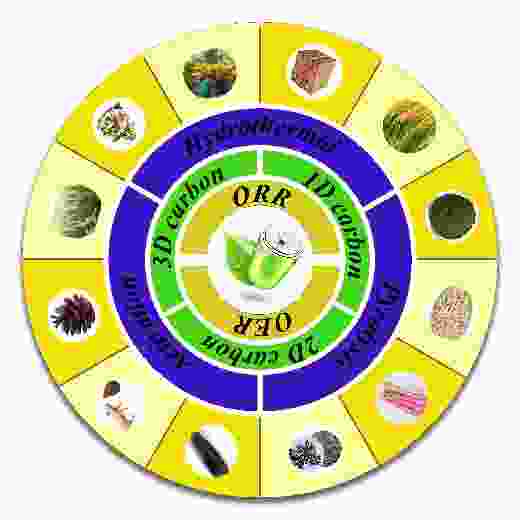
 下载:
下载:
